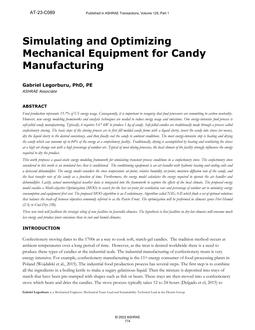Click here to purchase
Food production represents 15.7% of US energy usage. Consequently, it is important to recognize that food processors are committing to carbon neutrality. However, new energy modeling frameworks and analysis techniques are needed to reduce energy usage and emissions. One energy-intensive food process is soft-jelled candy manufacturing. Typically, it requires 5.67 kW to produce 1 kg of candy. Soft-jelled candies are traditionally made through a process called confectionery stoving. The basic steps of the stoving process are to first fill molded candy forms with a liquid slurry, insert the candy into stoves (or ovens), dry the liquid slurry to the desired consistency, and then finally cool the candy to ambient conditions. The most energy-intensive step is heating and drying the candy which can consume up to 84% of the energy at a confectionery facility. Traditionally, drying is accomplished by heating and ventilating the stoves at a high air change rate with a high percentage of outdoor air. Typical of most drying processes, the local climate of the facility strongly influences the energy required to dry the product. This work proposes a quasi-static energy modeling framework for simulating transient process conditions in a confectionery stove. The confectionery stove considered in this work is an insulated box that is conditioned. The conditioning equipment is an air-handler with hydronic heating and cooling coils and a desiccant dehumidifier. The energy model considers the stove temperature set-point, relative humidity set-point, moisture diffusion rate of the candy, and the heat transfer rate of the candy as a function of time. Furthermore, the energy model calculates the energy required to operate the air handler and dehumidifier. Lastly, actual meteorological weather data is integrated into the framework to capture the effects of the local climate. The proposed energy model enables a Multi-objective Optimization (MOO) to search for the best set-point for ventilation rate and percentage of outdoor air to minimize energy consumption and equipment first cost. The proposed MOO algorithm is an Evolutionary Algorithm called NSGA-II which finds a set of optimal solutions that balance the trade-off between objectives commonly referred to as the Pareto Front. The optimization will be performed in climates zones Hot-Humid (2A) to Cool-Dry (5B). These new tools will facilitate the strategic siting of new facilities in favorable climates. The hypothesis is that facilities in dry-hot climates will consume much less energy and produce fewer emissions than in cool and humid climates.
Product Details
- Published:
- 2023
- Number of Pages:
- 8
- Units of Measure:
- Dual
- File Size:
- 1 file , 1.6 MB
- Product Code(s):
- D-AT-23-C089
- Note:
- This product is unavailable in Russia, Belarus
